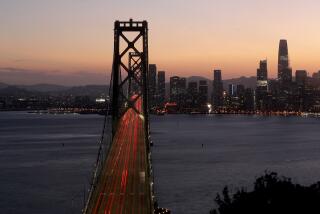Steps to offset the ‘carbon footprint’ from your trip
HERE’S the modern traveler’s dilemma: You love to travel but worry about the environment, and you know that flying or even driving to your destination leaves a carbon footprint, a measure of how your activities affect the environment.
To mitigate the harm a trip can cause -- including fossil fuels burned to get you where you’re going -- travelers today can buy carbon offsets. And some travel companies have joined the green trend, making it easier to offset the environmental impact of your journey.
The concept is simple: You contribute to companies or organizations that implement or manage projects that avoid, reduce or absorb offending greenhouse gases through renewable energy (solar and wind power, for example); encourage energy efficiency (smarter appliances and lightbulbs); and use forest and other green projects to suck up carbon dioxide.
Opinion is still divided on whether offsets are guilt money or whether they help a stressed-out planet.
Julia Bovey thinks carbon offsets can increase awareness about global warming. But, says Bovey, federal communications director for the Natural Resources Defense Council, a nonprofit environmental group that protects people and natural resources, consumers should do their homework so they know where and how their money is spent.
That way, they can decide whether their money is better spent replacing incandescent bulbs with efficient compact fluorescents or buying offsets, said Jeff Sharp, a spokesperson for the House Select Committee on Energy Independence and Global Warming.
Sharp recommends reading “A Consumer’s Guide to Retail Offset Pro- viders” at www.cleanair-coolplanet.org and a Tufts University Climate Initiative report evaluating 13 offsetters, available at www.tufts.edu/tie/tci/carbonoffsets/. Following experts’ advice, I looked at the four companies Tufts liked best to decide where to buy offsets for trips to Kona, Hawaii, and Dallas. Here’s what I found:
* NativeEnergy (www.nativeenergy.com). Cost: $24 for Hawaii and $12 for Dallas. NativeEnergy has a wind turbine project in Colorado and two methane projects in Pennsylvania. You can earmark contributions for 100% wind, 100% farm methane or half and half.
* AtmosFair ( www.atmosfair.de, then click on the British flag, lower left). Cost: 45 euros ($67) for Hawaii and 25 euros ($37) for Dallas. AtmosFair determines which climate-protection project gets your funds. For instance, a project in India helps people cook using solar mirrors instead of diesel fuel. Offsets are 100% or 50%.
* Climate Friendly (www.climatefriendly.com). Cost: $47.40 for Hawaii and $23.34 for Dallas. This Australian company also lets you choose a 100% or 50% offset. It chooses where the money goes, but it may benefit the Hebei wind farm in China (40 wind turbines already operating).
* MyClimate ( www.myclimate.org). Cost: $27.73 for Hawaii and $14.76 for Dallas). Projects include wind power in Madagascar or alternative energy in Switzerland.
Considering my budget, I chose NativeEnergy.
Increasingly, you can offset your carbon footprint through an airline when you buy a ticket. (Virgin Atlantic even sells offsets aboard its flights.)
Lufthansa and Virgin Atlantic, for instance, are partnered with MyClimate. British Airways uses ClimateCare.org. Air Canada offsets using ZeroFootprint .net, and Air France’s offsets through ActionCarbone.org.
Domestically, Delta sells $5.50 domestic or $11 international offsets using Conservation Fund (www.conservationfund.org), which plants native trees in the U.S. and abroad. MyClimate’s U.S. partner, Sustainable Travel International (www.sustainabletravelinternational.org), is Continental’s offset vendor.
Orbitz, Expedia, Travelocity and the Auto Club of Southern California’s website (through Travelocity) also offer offsets. Orbitz uses Carbon Fund (www.carbonfund.org), Expedia chose TerraPass ( www.terrapass.com). Travelocity, like Delta, chose the Conservation Fund.
Brian Mullis of Sustainable Travel encourages travelers to tread lightly on vacation.
“Natural and cultural resources are precious, and the size of your ‘footprint’ affects the future of the people and places you visit,” he said. “Until we travel without burning fossil fuels, the environment will pay a price. . . . If buying offsets can make a difference, how can we not take responsibility for our environmental impact?”
More to Read
Sign up for The Wild
We’ll help you find the best places to hike, bike and run, as well as the perfect silent spots for meditation and yoga.
You may occasionally receive promotional content from the Los Angeles Times.






